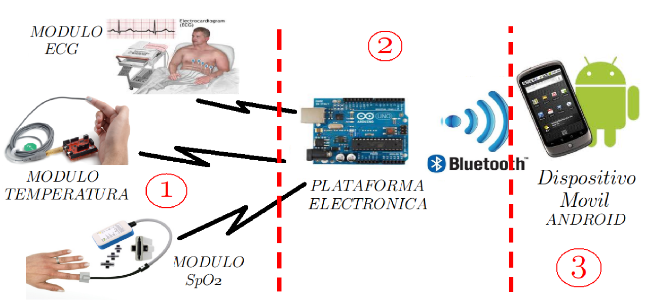Monitoring vital signs through a network of mobile devices
Main Article Content
Abstract
The development and implementation of different technological projects, supported by the corresponding medical knowledge, can contribute to solving various problems in the health sector. Although enormous efforts have been made in recent years to develop technologies applicable to clinical environments, developing technologies for home healthcare could reduce the pressure that currently overwhelms hospitals. In this project, the design and implementation of a system for monitoring vital signs is carried out, which measures a person's heart rate, blood oxygenation, and body temperature. The information obtained from each vital sign is sampled and processed by a digital platform and subsequently sent through a Bluetooth module to a mobile device for analysis and visualization. The prototype was evaluated through a battery of tests to measure vital signs in different patients.
Downloads
Article Details

This work is licensed under a Creative Commons Attribution 4.0 International License.
Authors who publish in this journal agree to the following terms: Authors retain the copyright and guarantee the journal the right to be the first publication of the work, as well as, licensed under a Creative Commons Attribution License that allows others share the work with an acknowledgment of the authorship of the work and the initial publication in this journal. Authors may separately establish additional agreements for the non-exclusive distribution of the version of the work published in the journal (for example, placing it in an institutional repository or publishing it in a book), with acknowledgment of its initial publication in this journal. Authors are allowed and encouraged to disseminate their work electronically (for example, in institutional repositories or on their own website) before and during the submission process, as it may lead to productive exchanges as well as further citation earliest and oldest of published works.
How to Cite
References
[2] Medline Plus. Signos Vitales. http://www.nlm.nih.gov/medlineplus/spanish/ency/article/002341.htm",year = 1997, note =.
[3] D C Godoy León. Proyecto diseño y construcción de una plataforma de telemedicina para el monitoreo de bioseñales. http://www.dalcame.com/wdescarga/ecg12.pdf, 2008. [Online; accessed 12-Feb-2012].
[4] Francis Cozal. Electrocardiograma. https://es.wikipedia.org/wiki/Electrocardiograma, 2013. [Online; accessed 08-Feb-2013].
[5] Seco González A. Noguerol Casado MJ. Pulsioximetría. http://www.fisterra.com/material/tecnicas/pulsioximetria/pulsioximetria.pdf. [Online; accessed 08-Feb-2013].
[6] Santiago Lopez. Pulse Oximeter Fundamentals and Design. http://www.freescale.com/files/32bit/doc/app_note/AN4327.pdf, 2012. [Online; accessed 08-Feb-2013].
[7] University Of Chicago. Signos Vitales: Temperatura Corporal, Pulso, Frecuencia Respiratoria y Presión Sanguínea. http://www.uchospitals.edu/online-library/content=S03963, 2013. [Online; accessed 01-Marzo-2013].
[8] Sensirion. SHT15. http://www.sensirion.com/en/products/humidity-temperature/humidity-sensor-sht15/. [Online; accessed 01-Marzo-
2013].
[9] NONIN. Sensores Spo2 Nonin. http://www.nonin.com/PulseOximetry/Sensors. [Online; accessed 01-Marzo-2013].
[10] MCM. Arduino Uno vs Raspberry Pi vs BeagleBone Black. http://blog.mcmelectronics.com/post/Arduino-Uno-Raspberry-Pi-and-BeagleBone-Black#.UeXP8c9qYxA, 2013. [Online; accessed 16-Jul-2013].

